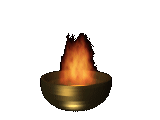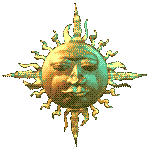 The Wiccan Sabbats
The Wiccan Sabbats

Wiccans celebrate eight festivals, called "Sabbats," as a means of attunement to the seasonal rhythms of Nature. The "Wheel of the Year" has eight spokes or "Sabbats". Four of these represent major agricultural and pastoral festivals and the remaining four represent the minor solar festivals of the solstices and equinoxes. While there are other days of celebration on the witch's calendar, this is a list of the eight "primary holidays".
In many traditions one day ends and another begins at sundown so if a holiday is listed as beginning on the 31st, it will begin at sunset on the 31st and end at sunset on the 1st.
THESE ARE:
January 31 -- [Called Imbolc, Brigit, or February Eve], Also known as Candlemas and Brigid's Day. Also coincides with Groundhog's Day. The days begin to lengthen and Spring is on it's way. We focus on the revival of life. It's time to prepare for the welcoming of spring and a time of new beginnings, a choice time for dedication or re-dedication to the Goddess and God.
March 21 -- [Ostara or Spring Equinox], Vernal Equinox The first planting festival. The days and nights are now equal and spring arrives to awaken our world. From here the "Easter Bunny" takes his tradition of colored eggs and baskets teaming with flowers. We rejoice in the Mother's gift of rebirth and fertility.
April 30 -- [Beltane or May Eve], "Mayday" The last Spring Fertility Festival. It's time to be merry and dance around the maypole, which is a symbol of fertility. At the fertility festivals you see the witches leaping joyously over the fires to bring good luck. We now celebrate the union of the Goddess and God.
June 22 -- [Midsummer, Litha or Summer Solstice], This is the longest day of the year. This marks the beginning of the harvest season. A very magickal time when we celebrate the fruits of our labor during the years early harvest. Many say that whatever you dream on this night will surely come your way.
July 31 -- [Lunasa or Lammas], August Eve - The first harvest festival. The nights grow longer and the grains of the first harvest are used for making the ritual bread.
September 21 -- [Harvest, Mabon, or Autumn Equinox], - Autumn Equinox The second harvest festival. The completion of the harvest and time for the darkness of night to take over again. A time for thanksgiving. We celebrate and rejoice to our Mother, thanking her for all she has given us.
October 31-- [Samhain, Sowyn or Hollows], "Halloween" This holiday is considered the Witches' New Year's Eve. A time of reflection, remembering those who have gone before us. It's the night when the barriers between the worlds of life and death are very thin, allowing our ancestors to walk among us and bestow their blessings upon is. The nights begin to lengthen and giving us more time with the moon and stars.
December 21-- [Yule or Winter Solstice]. Winter Solstice This is the longest night of the year. This is the festival of the Sun's rebirth. We honor the Goddess for giving birth to the sun. From here you'll find the christians have borrowed a few things for their "christmas". Such as our Yule Log, Yule Tree, mistletoe over the doorway and even the exchanging of gifts.
Some groups find meetings within a few days of those dates to be acceptable, others require the precise date. In addition, most groups will meet for worship at each Full Moon, and many will also meet on the New Moon. Meetings for religious study will often be scheduled at any time convenient to the members, and rituals can be scheduled whenever there is a need (i.e. for a healing).

How to close the circle: Starting again at the north, take your athame or index finger and move in a clockwise motion, visualizing the pure white light of your circle being drawn into the blade or your finger. I usually say "The circle is open yet unbroken" while doing this. Finish in the north and either ground the energy by dispersing it into the earth or save it in your athame for use at a later time. Always thank the quarters before you close the circle, as well as any deities or other beings you've invited in your working.
